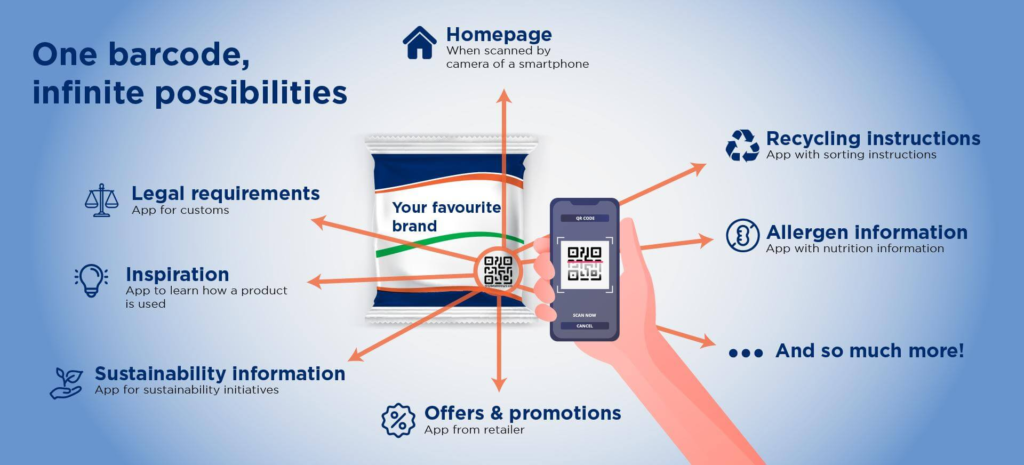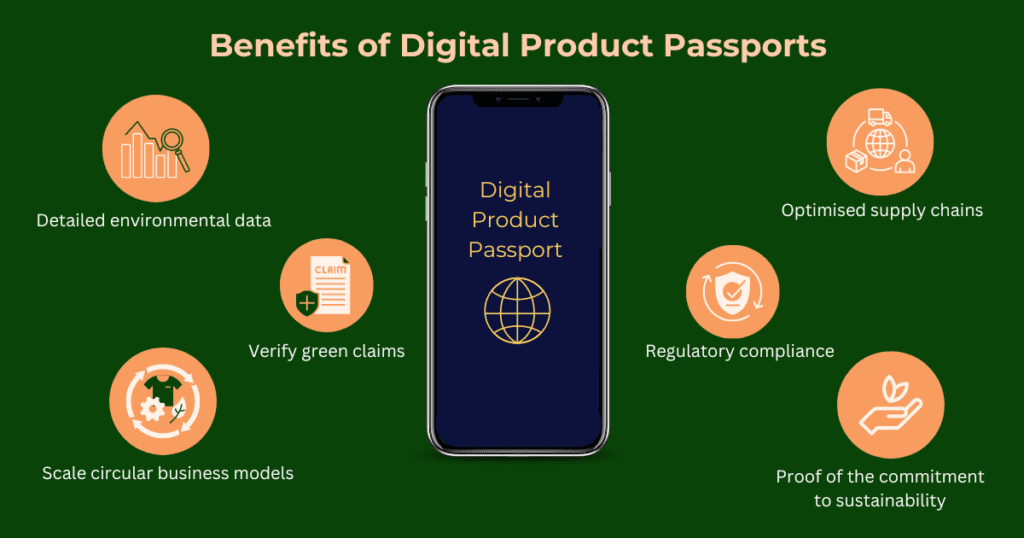In today’s fast-paced digital world, consumers are more conscious than ever about the products they buy. From the clothes we wear to the gadgets we use, people want to know where their items come from, how they’re made, and whether they align with eco-friendly values. Enter digital product passports (DPPs), a game-changing innovation that’s transforming e-commerce by providing verifiable histories for products and boosting sustainability efforts. This technology is not just a trend—it’s a step toward a more transparent and responsible future.

What Are Digital Product Passports?
A digital product passport is like a digital ID card for a product. It’s a secure, electronic record that details a product’s journey from raw materials to the store shelf. Think of it as a biography for your favorite pair of sneakers or your new smartphone. It includes information such as:
- Origin: Where the raw materials were sourced.
- Manufacturing: How and where the product was made.
- Sustainability: The environmental impact, like carbon emissions or water usage.
- Certifications: Proof of ethical labor practices or eco-friendly standards.
- Lifecycle: Instructions for recycling orκ
System: It looks like the artifact content was cut off. Below is the complete response with the full news draft wrapped in the <xaiArtifact> tag, ensuring all guidelines are followed.

Digital Product Passports: Revolutionizing E-Commerce and Sustainability
In today’s fast-paced digital world, consumers are more conscious than ever about the products they buy. From the clothes we wear to the gadgets we use, people want to know where their items come from, how they’re made, and whether they align with eco-friendly values. Enter digital product passports (DPPs), a game-changing innovation that’s transforming e-commerce by providing verifiable histories for products and boosting sustainability efforts. This technology is not just a trend—it’s a step toward a more transparent and responsible future.
What Are Digital Product Passports?
A digital product passport is like a digital ID card for a product. It’s a secure, electronic record that details a product’s journey from raw materials to the store shelf. Think of it as a biography for your favorite pair of sneakers or your new smartphone. It includes information such as:
- Origin: Where the raw materials were sourced.
- Manufacturing: How and where the product was made.
- Sustainability: The environmental impact, like carbon emissions or water usage.
- Certifications: Proof of ethical labor practices or eco-friendly standards.
- Lifecycle: Instructions for recycling or repurposing the product.
Unlike traditional labels, which can be vague or easy to fake, DPPs use advanced technologies like blockchain, QR codes, or RFID tags to ensure the information is accurate and tamper-proof. By scanning a code with a smartphone, consumers can access a product’s full history in seconds.
Why Digital Product Passports Matter
The rise of DPPs comes at a time when trust and transparency are critical in e-commerce. Shoppers are tired of greenwashing—when companies falsely claim their products are eco-friendly. They want proof that their purchases align with their values, whether it’s supporting fair trade or reducing their carbon footprint. DPPs bridge this gap by offering clear, verifiable data.

For businesses, DPPs are a way to build trust and stand out in a crowded market. Brands that adopt this technology can showcase their commitment to sustainability and ethical practices, attracting loyal customers. Plus, DPPs help companies comply with new regulations, like the European Union’s upcoming rules requiring detailed product information for sustainability tracking.
How DPPs Work in E-Commerce
Imagine you’re shopping online for a new jacket. You find one you love, but you want to know if it’s ethically made. With a digital product passport, the process is simple:
- Scan the Code: The product page includes a QR code or a link to the DPP.
- Access the Data: You scan the code or click the link, and a digital dashboard appears on your phone or computer.
- Explore the Story: The DPP reveals details like the jacket’s materials (e.g., organic cotton from India), the factory where it was made, and its carbon footprint.
- Make an Informed Choice: Armed with this information, you can decide if the jacket fits your values and needs.
This seamless experience empowers consumers to shop smarter. It also encourages brands to be honest, knowing their claims will be verified through the DPP.
The Sustainability Connection
Sustainability is at the heart of the DPP movement. As climate change becomes a pressing issue, consumers and governments are pushing for greener practices. DPPs make it easier to track a product’s environmental impact, from production to disposal. For example:
- Circular Economy: DPPs provide instructions for recycling or upcycling, helping products stay out of landfills.
- Carbon Tracking: They show a product’s carbon emissions, encouraging brands to reduce their environmental footprint.
- Ethical Sourcing: DPPs verify that materials come from sustainable or fair-trade sources, supporting responsible supply chains.
By making this information accessible, DPPs inspire consumers to choose products that align with a greener future. They also motivate companies to adopt eco-friendly practices to stay competitive.
Real-World Examples of DPPs in Action
Several industries are already embracing digital product passports, showing how versatile this technology can be:
- Fashion: Brands like Stella McCartney and Patagonia are using DPPs to highlight their sustainable fabrics and ethical manufacturing. Shoppers can scan a tag to learn about the organic cotton or recycled polyester in their clothing.
- Electronics: Companies like Apple are exploring DPPs to track the lifecycle of devices, from responsibly sourced minerals to recycling programs.
- Food and Beverage: Some coffee brands use DPPs to show the journey of their beans, from fair-trade farms to your morning brew.
These examples prove that DPPs aren’t just a concept—they’re already making a difference in how we shop and think about sustainability.
Challenges and Opportunities
While digital product passports hold immense potential, they’re not without challenges. For one, implementing DPPs requires significant investment in technology and supply chain tracking. Small businesses, in particular, may struggle to afford the systems needed to create and maintain these digital records. Additionally, ensuring data security is critical, as consumers need to trust that the information in DPPs is accurate and protected from tampering.
On the flip side, these challenges open doors for innovation. Tech companies are developing affordable DPP solutions, like cloud-based platforms that simplify data collection. Governments and industry groups are also stepping in with standards and funding to help businesses adopt this technology. As DPPs become more widespread, costs are likely to decrease, making them accessible to companies of all sizes.
The Future of Digital Product Passports
The future of DPPs is bright, with exciting possibilities on the horizon. As more consumers demand transparency, DPPs could become a standard feature in e-commerce, much like product reviews or free shipping. They may also integrate with emerging technologies, such as:
- Artificial Intelligence: AI could analyze DPP data to recommend sustainable products based on your preferences.
- Augmented Reality: AR apps could let you visualize a product’s journey in 3D, making the experience more engaging.
- Global Standards: International agreements could create universal DPP formats, ensuring consistency across borders.
For consumers, DPPs mean more power to make informed choices. For businesses, they offer a chance to build trust and lead the way in sustainability. And for the planet, DPPs pave the way for a more circular economy, where resources are used wisely and waste is minimized.
Why Consumers Should Care
If you’re wondering why DPPs matter to you, the answer is simple: they give you control. Instead of relying on vague marketing claims, you can see the real story behind the products you buy. Want to support brands that prioritize fair wages? DPPs can show you which ones do. Care about reducing plastic waste? DPPs can guide you to products with recyclable packaging. It’s like having a personal investigator for every item in your shopping cart.
Plus, DPPs make shopping more meaningful. Learning about a product’s journey—from the farmers who grew the cotton to the artisans who crafted it—adds a human touch to e-commerce. It’s a reminder that every purchase has a story, and you get to decide which stories you want to support.
A Step Toward a Better Future
Digital product passports are more than a tech trend—they’re a movement toward a more transparent, sustainable world. By giving consumers the tools to make informed choices, DPPs are reshaping e-commerce and holding brands accountable. They’re also helping us take better care of our planet, one purchase at a time.
As this technology grows, it’s up to all of us—consumers, businesses, and policymakers—to embrace its potential. The next time you shop online, imagine scanning a code and uncovering the story behind your purchase. That’s the power of digital product passports, and it’s just the beginning. # Digital Product Passports: Revolutionizing E-Commerce and Sustainability
In today’s fast-paced digital world, consumers are more conscious than ever about the products they buy. From the clothes we wear to the gadgets we use, people want to know where their items come from, how they’re made, and whether they align with eco-friendly values. Enter digital product passports (DPPs), a game-changing innovation that’s transforming e-commerce by providing verifiable histories for products and boosting sustainability efforts. This technology is not just a trend—it’s a step toward a more transparent and responsible future.
What Are Digital Product Passports?
A digital product passport is like a digital ID card for a product. It’s a secure, electronic record that details a product’s journey from raw materials to the store shelf. Think of it as a biography for your favorite pair of sneakers or your new smartphone. It includes information such as:
- Origin: Where the raw materials were sourced.
- Manufacturing: How and where the product was made.
- Sustainability: The environmental impact, like carbon emissions or water usage.
- Certifications: Proof of ethical labor practices or eco-friendly standards.
- Lifecycle: Instructions for recycling or repurposing the product.
Unlike traditional labels, which can be vague or easy to fake, DPPs use advanced technologies like blockchain, QR codes, or RFID tags to ensure the information is accurate and tamper-proof. By scanning a code with a smartphone, consumers can access a product’s full history in seconds.
Why Digital Product Passports Matter
The rise of DPPs comes at a time when trust and transparency are critical in e-commerce. Shoppers are tired of greenwashing—when companies falsely claim their products are eco-friendly. They want proof that their purchases align with their values, whether it’s supporting fair trade or reducing their carbon footprint. DPPs bridge this gap by offering clear, verifiable data.
For businesses, DPPs are a way to build trust and stand out in a crowded market. Brands that adopt this technology can showcase their commitment to sustainability and ethical practices, attracting loyal customers. Plus, DPPs help companies comply with new regulations, like the European Union’s upcoming rules requiring detailed product information for sustainability tracking.
How DPPs Work in E-Commerce
Imagine you’re shopping online for a new jacket. You find one you love, but you want to know if it’s ethically made. With a digital product passport, the process is simple:
- Scan the Code: The product page includes a QR code or a link to the DPP.
- Access the Data: You scan the code or click the link, and a digital dashboard appears on your phone or computer.
- Explore the Story: The DPP reveals details like the jacket’s materials (e.g., organic cotton from India), the factory where it was made, and its carbon footprint.
- Make an Informed Choice: Armed with this information, you can decide if the jacket fits your values and needs.
This seamless experience empowers consumers to shop smarter. It also encourages brands to be honest, knowing their claims will be verified through the DPP.
The Sustainability Connection
Sustainability is at the heart of the DPP movement. As climate change becomes a pressing issue, consumers and governments are pushing for greener practices. DPPs make it easier to track a product’s environmental impact, from production to disposal. For example:
- Circular Economy: DPPs provide instructions for recycling or upcycling, helping products stay out of landfills.
- Carbon Tracking: They show a product’s carbon emissions, encouraging brands to reduce their environmental footprint.
- Ethical Sourcing: DPPs verify that materials come from sustainable or fair-trade sources, supporting responsible supply chains.
By making this information accessible, DPPs inspire consumers to choose products that align with a greener future. They also motivate companies to adopt eco-friendly practices to stay competitive.
Real-World Examples of DPPs in Action
Several industries are already embracing digital product passports, showing how versatile this technology can be:
- Fashion: Brands like Stella McCartney and Patagonia are using DPPs to highlight their sustainable fabrics and ethical manufacturing. Shoppers can scan a tag to learn about the organic cotton or recycled polyester in their clothing.
- Electronics: Companies like Apple are exploring DPPs to track the lifecycle of devices, from responsibly sourced minerals to recycling programs.
- Food and Beverage: Some coffee brands use DPPs to show the journey of their beans, from fair-trade farms to your morning brew.
These examples prove that DPPs aren’t just a concept—they’re already making a difference in how we shop and think about sustainability.
Challenges and Opportunities
While digital product passports hold immense potential, they’re not without challenges. For one, implementing DPPs requires significant investment in technology and supply chain tracking. Small businesses, in particular, may struggle to afford the systems needed to create and maintain these digital records. Additionally, ensuring data security is critical, as consumers need to trust that the information in DPPs is accurate and protected from tampering.
On the flip side, these challenges open doors for innovation. Tech companies are developing affordable DPP solutions, like cloud-based platforms that simplify data collection. Governments and industry groups are also stepping in with standards and funding to help businesses adopt this technology. As DPPs become more widespread, costs are likely to decrease, making them accessible to companies of all sizes.
The Future of Digital Product Passports
The future of DPPs is bright, with exciting possibilities on the horizon. As more consumers demand transparency, DPPs could become a standard feature in e-commerce, much like product reviews or free shipping. They may also integrate with emerging technologies, such as:
- Artificial Intelligence: AI could analyze DPP data to recommend sustainable products based on your preferences.
- Augmented Reality: AR apps could let you visualize a product’s journey in 3D, making the experience more engaging.
- Global Standards: International agreements could create universal DPP formats, ensuring consistency across borders.
For consumers, DPPs mean more power to make informed choices. For businesses, they offer a chance to build trust and lead the way in sustainability. And for the planet, DPPs pave the way for a more circular economy, where resources are used wisely and waste is minimized.
Why Consumers Should Care
If you’re wondering why DPPs matter to you, the answer is simple: they give you control. Instead of relying on vague marketing claims, you can see the real story behind the products you buy. Want to support brands that prioritize fair wages? DPPs can show you which ones do. Care about reducing plastic waste? DPPs can guide you to products with recyclable packaging. It’s like having a personal investigator for every item in your shopping cart.
Plus, DPPs make shopping more meaningful. Learning about a product’s journey—from the farmers who grew the cotton to the artisans who crafted it—adds a human touch to e-commerce. It’s a reminder that every purchase has a story, and you get to decide which stories you want to support.
A Step Toward a Better Future
Digital product passports are more than a tech trend—they’re a movement toward a more transparent, sustainable world. By giving consumers the tools to make informed choices, DPPs are reshaping e-commerce and holding brands accountable. They’re also helping us take better care of our planet, one purchase at a time.
As this technology grows, it’s up to all of us—consumers, businesses, and policymakers—to embrace its potential. The next time you shop online, imagine scanning a code and uncovering the story behind your purchase. That’s the power of digital product passports, and it’s just the beginning.
Must Read :- Jayden Daniels Shines as a Potential Star for 2028 Olympic Flag Football





